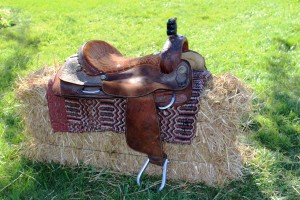Two Important Principles Learned from Horses
By Rad Watkins
This month I have been focusing on lessons learned from horses. This is a big part of my life these days and I am actually working on a new book that will explore leadership lessons learned from horses. There are two lessons from horsemanship that have proven to be very helpful to me lately. The first has to do with requests we put on the horse and the second has to do with expected outcomes.

The Cues We Give
Sometimes we give a horse a cue to perform a movement, and if it doesn’t respond right away so we increase the cue. A cue is our way of requesting the horse do something and it is usually amplified by some degree of irritation. Simply put, if at first the cue doesn’t work, human nature leads us to increase the level of irritation associated with the cue, until the horse responds with the correct answer.
What I have found while riding is if you don’t give the horse time to respond, you might increase the irritation when the horse is already trying. The horse can then get frustrated and foul tempered. The lesson here is to make a request and see how it plays out, give the other individual time to digest the information and respond. This is especially true when teaching. There is a saying that you should never discipline a horse who is trying. This is true in so many aspects of human interactions too.
A Second Lesson
The second lesson relates directly to the first, and is a pillar of good horsemanship. That is patience. Patience is one of the keys to working with a horse. Often when working with a horse, things do not go as you hope they might. Sometimes you want to have a certain outcome and it is just not happening. It is easy to get frustrated and even mad at the horse, but this is always the wrong thing to do. You must be patient.
The horse will usually try to do what you are asking if it understands and doesn’t have other things on its mind. Sometimes it does, and things just don’t work out for you. In these cases, you don’t want to freak out on, yell at, or beat up your horse. You want to be patient, and go back to a place where you know things will be good. From there you can see if you’re ready for the next step, or if you need to break it down some more.
I can remember days where I had an allotted an hour to go for a trail ride but my horse did not want to leave the barn. Instead of riding the trail that day we might work on walking 10 feet away from the barn, and back to the barn. Then 11 feet, and back. Then 12 feet, and back. You get the picture. You want to leave at a good spot, not a fight.
Practice Patience
So this week as you are interacting with family, friends, and colleagues, practice letting them have time to react to you before you make assumptions about what they need or mean. Also, practice patience and if you for some reason don’t see eye-to-eye, get back to a place of mutual understanding and leave it there. You don’t have to always win in healthy relationships.
Good luck with these lessons, and feel free to contact me if you ever feel like visiting my pasture and horsing around. It is amazing what working with these animals can teach us.
Keep leading,
Rad
